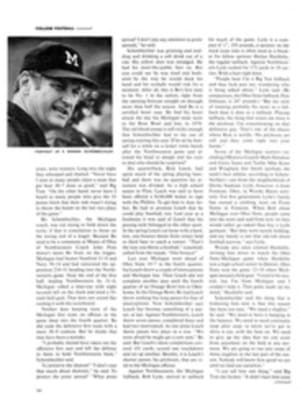
Ditching the dream
It was weird, unpredictable, disappointing, but the climax of Ed Yost's attempt was entirely in keeping with the tradition of attempted transatlantic crossings. There was Yost and his 80-foot-high, helium-filled balloon gently descending to the sea 200 nautical miles east of the Azores, having drifted 2,520 miles in 107 hours and 35 minutes, while beneath him a Russian ship was trying to outrace a West German freighter and a Portuguese coast guard ship to make the rescue.
Why this almost comic finale to Yost's grand adventure? Purely a matter of economics. After another Russian ship picked up Karl Thomas when he ditched in the North Atlantic earlier this summer, Thomas reportedly received a bill for $100,000.
Forty-eight hours after the Elisabeth Bolten rescued Yost, and his wallet, from the fast-closing Russians—charging $5,000 for the ride—he waved a final goodby to his West German rescuers, struck a heroic pose at the tiller, and steered his red and white gondola, which was being towed by a motor launch, into the harbor beneath the towering Rock of Gibraltar. The sun was bright, the wind was fresh, and the boxy little catamaran danced jauntily over the waves. Such was the last mile of the most successful failure in the history of long-distance ballooning.
In all, Yost broke eight world records in four ballooning categories, including all-class endurance and distance records that had stood for more than 60 years. And he did it at low altitude in an open gondola, without help from the jet stream.
None of this surprises those who know the man. Alone among the rash of would-be transatlantic balloonists, the 57-year-old Yost was the one the cognoscenti took seriously. He is the holder of some 20 balloon-related patents, builder of the balloons used in films like The Great Bank Robbery and The Great Race and a veteran of high-altitude test flights for NASA and the armed services. Thus he is a thoroughgoing professional balloonist, not a dilettante or a publicity seeker.
Yost's professionalism was reflected in every aspect of the transatlantic try. His 60,000-cubic-foot balloon, dubbed the Silver Fox, was patterned after the heavy-duty balloons used in the north woods to haul timber down mountainsides. It had been built of neoprene-coated nylon fabric in Yost's own factory in Sioux Falls, S. Dak. Beneath the towering silver and black gas bag, Yost rode in a 13-by-6-foot fiber-glass gondola stuffed with a welter of sophisticated radio gear including a continuously operating radio beacon that gave the balloon's altitude, four VHF voice transceivers (two for ships, two for aircraft), another voice transceiver for ground communications and an emergency locator beacon. Unlike his less meticulously prepared predecessors (five of whom died making the attempt in the past six years), Yost was in contact with tracking stations in Washington and London every two or three hours. "There weren't five minutes in the entire trip when I couldn't contact somebody," he says.
Also crammed into the tiny catamaran-style, buoyant gondola were food, foul-weather gear, automatic trim-adjusting equipment, sleeping bags, water, cameras, two stoves and ballast: 250 pounds of BB shot in five-pound bags, another 58 pounds of sand in small bags and approximately 20 grapefruit-size rocks picked up at the last minute from the shore near his Milbridge, Maine takeoff point. Almost every item on board had been marked as to its weight, one exception being a toy mouse given to Yost by a Milbridge youngster shortly before takeoff. The fruit of 16 months' preparation, the Silver Fox had cost Yost and his backers an estimated $60,000.
So what went wrong? "Our weather forecasting," Yost says. "You have to forecast five days ahead of time, and I ran into a flow of air that instead of going north or coming straight in, turned clockwise." That unexpected wind current pushed the Silver Fox so far to the south that the attempt had to be abandoned. Had he continued, Yost would have picked up the northeast trade winds and been blown back to South America.
Things went well at first. Yost, wearing slacks, a sport shirt and a windbreaker, left the ground at 6:10 p.m. on Tuesday, Oct. 5. The Silver Fox drifted off on a northeasterly course that took him over the province of New Brunswick, past the mouth of the St. Lawrence River and out over Newfoundland into the North Atlantic. By Thursday he was some 250 miles east of Gander, about half a day ahead of schedule. Then the winds began blowing him toward the south, and the voyage became frustrating. "The distance between takeoff and landing was 2,520 miles," says Yost, "but the balloon covered many more miles than that. One day I actually went backward. All I could do was sit there and watch it happen."
In fact, he did more than just sit there. "It's not a comfortable ride," he says. "You work all the time. You can't go to sleep for long. Even when I slept I'd set the alarm clock for one hour, and one hour would go by and I'd wake up, check the flight instruments and go back to sleep for another hour. There's always something to do. The first thing I did in the morning was wind the barograph, then check the ballast supply, then get everything set up and laid out for the next evening's sunset [when ballast had to be released to counteract lost lift due to cooling of the gas bag]. At about 10 or 11 o'clock I'd try to make radio contact. At noon I'd do a sun shot with a sextant to figure out where I was...I just kept working all the time." One night the temperature dropped to 18°F. During the day, however, Yost wore normal street clothing. "In the day it's pretty warm," he says. "You're in a calm all the time. Since you're being carried by the wind, there is no relative wind, and the sun is very strong at that altitude."
Yost's diet during the voyage consisted mainly of canned food and fruit juice. He heated water for coffee only once before the stoves went over the side to decrease ballast. "We made a bad mistake when we brought the balloon from South Dakota to Maine," he says. "We put a bunch of mothballs in the balloon box to keep the mice out. Then we put my plastic water bottles on top of the balloon and closed the box. The water tasted like mothballs all the way across. I didn't drink much water."
As the Silver Fox was driven inexorably to the south, it became clear that Yost would eventually have to abandon the flight. He finally ditched at about 9 a.m. on Sunday, Oct. 10. "We decided on Saturday afternoon that we'd land the next morning at about 9 a.m. so that the ships would have a full day of light in which to pick me up."
Search aircraft found him at about 8 a.m. Sunday and were able to follow him down even though there was rain. After putting out a 700-foot nylon drag line weighing 100 pounds to hold the balloon relatively stationary, Yost went about converting the gondola to a boat by installing rudders and checking to see that everything was seaworthy. Then he valved the balloon down close to the water. "When I was about four feet off," Yost says, "I pulled the rip panel partially so the balloon would start losing helium and wouldn't be floating off by itself, a derelict." After Yost disconnected the balloon from the gondola, he watched it rise to about 5,000 feet before slowly coming down into the ocean. But despite Yost's precautions, the balloon could not be recovered. Three hours later, as Yost was on the bridge of the Elisabeth Bolten radioing news of his rescue, the balloon sank. "That was a real loss," he says. "We spent a lot of time and hard work building it, and we probably won't have the patience to build another one."
Still, Yost claims to be satisfied with his flight. "We set out in the beginning to use modern equipment and modern techniques and fabrics to build a balloon that would stay in the air longer than these people who've been going out for about 10 hours, some of them not even getting beyond sight of shore. It would have been nice to have made land, but what the heck, we were prepared for water and that's where we ended up."
Yet there were some cracks in Yost's wall of satisfaction. He was visibly annoyed with the quality of the weather forecasting he received, some of it contradictory. In unguarded moments, he admitted frustration at being balked by winds at the altitudes he had to maintain during the day while watching the clouds below him moving in the direction he wanted to go.
The annoyance is understandable. World records are fine, but they do not capture the public imagination the way an Atlantic crossing would. Nevertheless, Ed Yost, a throwback to the days when rugged individuals tried to conquer time, mountains and geography just because they were a challenge, can take consolation in small things. On a visit to the gondola the day after landing, a Gibraltar customs agent greeted him, quite sincerely and simply, by asking: "Are you the hero?"
PHOTO
PHOTO
YOST AND HIS CATAMARAN-GONDOLA MADE GIBRALTAR—AT THE END OF A TOWROPE

